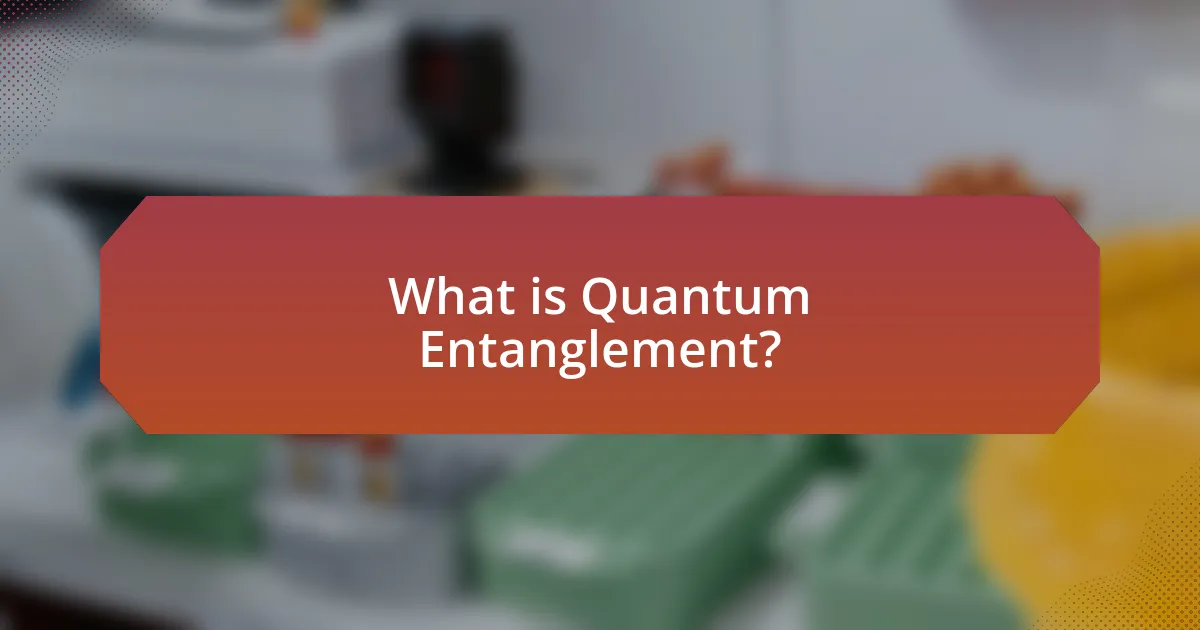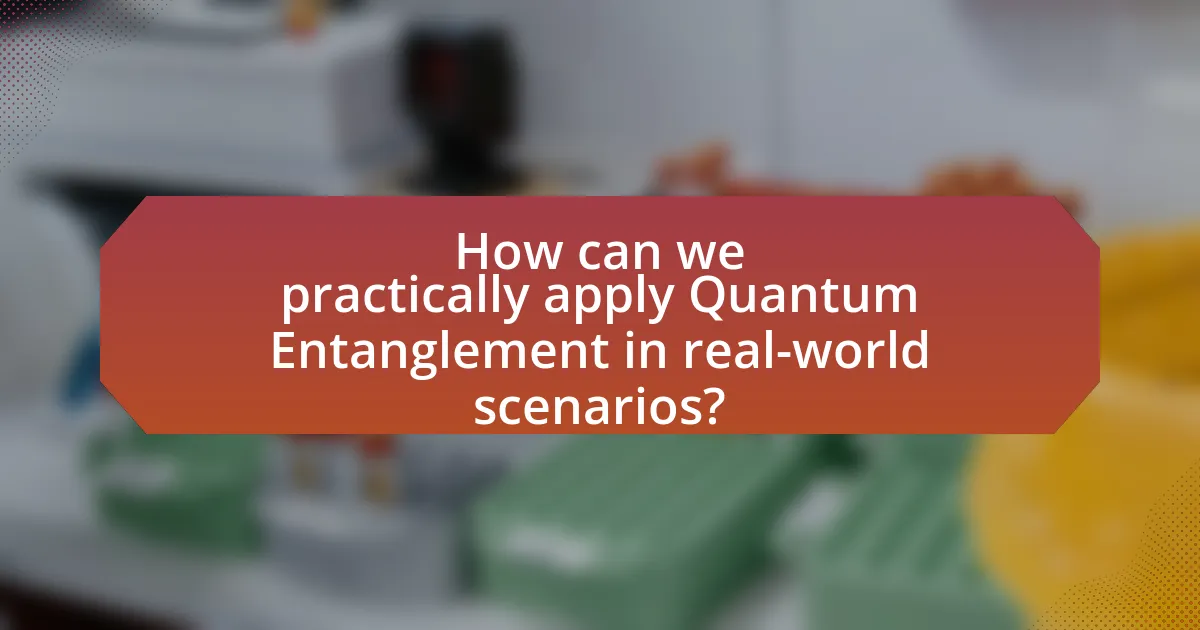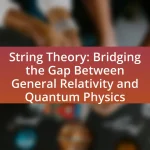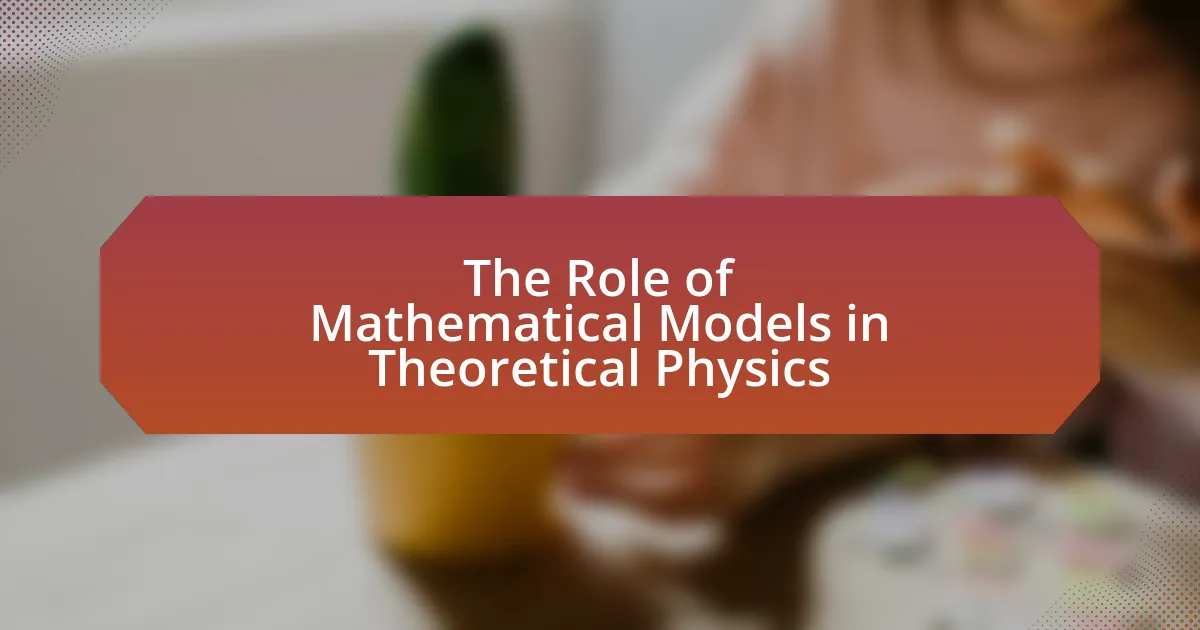Quantum entanglement is a fundamental phenomenon in quantum mechanics where particles become interconnected, allowing the state of one particle to instantaneously influence another, regardless of distance. This article explores the mechanisms behind quantum entanglement, its key characteristics, and its implications for information theory, particularly in quantum computing and cryptography. It discusses how entangled particles challenge classical information theory, enhance data transmission and security, and presents potential applications in technology. Additionally, the article addresses the challenges and limitations faced in harnessing quantum entanglement for practical use, along with strategies to overcome these obstacles.

What is Quantum Entanglement?
Quantum entanglement is a quantum phenomenon where two or more particles become interconnected in such a way that the state of one particle instantaneously influences the state of the other, regardless of the distance separating them. This phenomenon was famously described by Albert Einstein as “spooky action at a distance” and is a fundamental aspect of quantum mechanics, as demonstrated in experiments like the Bell test experiments, which confirm that entangled particles exhibit correlations that cannot be explained by classical physics.
How does Quantum Entanglement occur?
Quantum entanglement occurs when two or more particles become correlated in such a way that the state of one particle instantaneously influences the state of another, regardless of the distance separating them. This phenomenon arises from the principles of quantum mechanics, particularly during interactions where particles share a quantum state, leading to a situation where their properties are interdependent. Experimental evidence, such as the Bell test experiments, has consistently demonstrated that entangled particles exhibit correlations that cannot be explained by classical physics, confirming the non-local nature of quantum mechanics.
What are the fundamental principles behind Quantum Entanglement?
Quantum entanglement is fundamentally based on the principles of superposition and non-locality. Superposition allows quantum particles to exist in multiple states simultaneously, while non-locality indicates that the state of one entangled particle is directly related to the state of another, regardless of the distance separating them. This phenomenon was famously illustrated by the Einstein-Podolsky-Rosen (EPR) paradox, which demonstrated that measurements on one particle instantaneously affect the other, suggesting that information can be shared faster than the speed of light. Experimental validations, such as those conducted by Alain Aspect in the 1980s, confirmed the predictions of quantum mechanics regarding entanglement, reinforcing its foundational role in quantum theory and its implications for fields like quantum computing and cryptography.
How do particles become entangled?
Particles become entangled through interactions that correlate their quantum states, such as when they are produced together in a process like particle collisions or decay. This correlation means that the state of one particle cannot be described independently of the state of the other, regardless of the distance separating them. For example, in a process called spontaneous parametric down-conversion, a single photon can split into two entangled photons, ensuring that measurements on one photon instantaneously affect the other. This phenomenon has been experimentally verified in numerous studies, including those by Aspect et al. in the 1980s, which demonstrated the violation of Bell’s inequalities, confirming the non-local nature of quantum entanglement.
What are the key characteristics of Quantum Entanglement?
Quantum entanglement is characterized by the phenomenon where two or more particles become interconnected in such a way that the state of one particle instantaneously influences the state of the other, regardless of the distance separating them. This non-local correlation defies classical physics and is a fundamental aspect of quantum mechanics, as demonstrated in experiments like the Bell test experiments, which confirm that entangled particles exhibit correlations that cannot be explained by classical means. Additionally, entanglement is essential for quantum information processes, such as quantum computing and quantum cryptography, where it enables secure communication and complex computational tasks that classical systems cannot achieve.
What is non-locality in the context of Quantum Entanglement?
Non-locality in the context of quantum entanglement refers to the phenomenon where particles that are entangled exhibit correlations in their properties regardless of the distance separating them. This means that a measurement performed on one particle instantaneously affects the state of the other particle, even if they are light-years apart. This behavior contradicts classical intuitions about locality, which assert that objects are only directly influenced by their immediate surroundings. Experimental evidence, such as the violation of Bell’s inequalities, supports the existence of non-locality, demonstrating that entangled particles can exhibit correlations that cannot be explained by local hidden variable theories.
How does measurement affect entangled particles?
Measurement affects entangled particles by causing a collapse of their quantum state, resulting in a definite outcome for one particle that instantaneously influences the state of the other, regardless of the distance separating them. This phenomenon is a fundamental aspect of quantum mechanics, illustrated by experiments such as the Bell test experiments, which demonstrate that entangled particles exhibit correlations that cannot be explained by classical physics. When one particle is measured, its quantum state becomes known, and the entangled partner’s state is instantly determined, showcasing the non-local nature of quantum entanglement.

What are the implications of Quantum Entanglement for Information Theory?
Quantum entanglement significantly impacts information theory by enabling the phenomenon of quantum communication, which allows for secure transmission of information. This is evidenced by the development of quantum key distribution (QKD) protocols, such as BB84, which utilize entangled particles to ensure that any eavesdropping can be detected due to the nature of quantum measurements. Additionally, entanglement facilitates superdense coding, where two classical bits can be transmitted using a single qubit, effectively increasing the capacity of communication channels. These implications demonstrate that quantum entanglement not only enhances information security but also optimizes data transmission efficiency, fundamentally altering traditional concepts in information theory.
How does Quantum Entanglement challenge classical information theory?
Quantum entanglement challenges classical information theory by demonstrating that particles can be interconnected in such a way that the state of one particle instantaneously influences the state of another, regardless of the distance separating them. This phenomenon contradicts classical notions of locality and separability, which assert that information cannot be transmitted faster than the speed of light and that systems can be described independently of one another. Experimental evidence, such as the Bell test experiments, has shown that entangled particles exhibit correlations that cannot be explained by classical physics, thereby necessitating a reevaluation of how information is understood and transmitted in quantum systems.
What is the concept of quantum bits (qubits) in relation to entanglement?
Quantum bits, or qubits, are the fundamental units of quantum information that can exist in multiple states simultaneously due to superposition. In relation to entanglement, qubits can become entangled, meaning the state of one qubit is directly related to the state of another, regardless of the distance separating them. This phenomenon allows for correlations between qubits that classical bits cannot achieve, enabling faster information processing and secure communication. The concept of entanglement was famously illustrated in the Einstein-Podolsky-Rosen (EPR) paradox, which demonstrated that entangled particles exhibit instantaneous correlations, a feature that underpins quantum computing and quantum cryptography.
How does entanglement enhance data transmission and security?
Entanglement enhances data transmission and security by enabling instantaneous communication between entangled particles, regardless of distance. This phenomenon allows for the transfer of information in a way that is fundamentally secure, as any attempt to intercept or measure the entangled particles alters their state, thereby alerting the communicating parties to potential eavesdropping. Research has shown that quantum key distribution (QKD), which utilizes entangled particles, can provide unbreakable encryption, as demonstrated in experiments like the one conducted by Pan et al. in 2012, where secure communication was achieved over long distances using entangled photons. This capability of entanglement to ensure both rapid data transfer and robust security measures makes it a pivotal element in advancing information theory.
What are the potential applications of Quantum Entanglement in technology?
Quantum entanglement has several potential applications in technology, particularly in quantum computing, quantum cryptography, and quantum communication. In quantum computing, entanglement enables faster processing and more efficient algorithms, as demonstrated by Google’s 2019 quantum supremacy experiment, which showcased a quantum computer solving a problem in 200 seconds that would take classical supercomputers thousands of years. In quantum cryptography, entanglement allows for secure communication methods, such as Quantum Key Distribution (QKD), which ensures that any eavesdropping can be detected, as evidenced by the successful implementation of QKD in various real-world scenarios, including the 2017 quantum satellite experiment by the Chinese Academy of Sciences. Additionally, quantum communication leverages entanglement to create networks that can transmit information instantaneously over long distances, potentially revolutionizing telecommunications.
How can Quantum Entanglement improve quantum computing?
Quantum entanglement can significantly improve quantum computing by enabling faster information processing and enhanced computational power. This phenomenon allows qubits that are entangled to share information instantaneously, regardless of the distance separating them, which can lead to more efficient algorithms and faster problem-solving capabilities. For instance, entangled qubits can perform complex calculations simultaneously, leveraging superposition and interference to explore multiple solutions at once. Research has shown that quantum algorithms, such as Shor’s algorithm for factoring large numbers, can achieve exponential speedup over classical counterparts when utilizing entangled states. This demonstrates that quantum entanglement is a crucial resource for achieving the full potential of quantum computing.
What role does Quantum Entanglement play in quantum cryptography?
Quantum entanglement plays a crucial role in quantum cryptography by enabling secure communication through the phenomenon of entangled particles. In quantum key distribution (QKD), entangled particles are used to generate shared secret keys between parties, ensuring that any eavesdropping attempts can be detected due to the fundamental principles of quantum mechanics. For instance, if an eavesdropper tries to intercept the entangled particles, the state of the particles will change, alerting the communicating parties to the presence of the eavesdropper. This property is backed by the no-cloning theorem, which states that it is impossible to create an identical copy of an arbitrary unknown quantum state, further enhancing the security of the communication.

How can we practically apply Quantum Entanglement in real-world scenarios?
Quantum entanglement can be practically applied in real-world scenarios through quantum computing and quantum cryptography. In quantum computing, entangled particles enable faster processing and complex problem-solving capabilities, as demonstrated by Google’s 2019 achievement of quantum supremacy, where their quantum computer performed a calculation in 200 seconds that would take classical supercomputers thousands of years. In quantum cryptography, entanglement is utilized to create secure communication channels, as seen in the implementation of Quantum Key Distribution (QKD) protocols like BB84, which leverage entangled states to ensure that any eavesdropping attempts can be detected, thus providing a higher level of security than classical methods.
What are the best practices for utilizing Quantum Entanglement in research?
The best practices for utilizing Quantum Entanglement in research include ensuring precise control over entangled states, employing robust error correction techniques, and integrating interdisciplinary approaches. Precise control is essential because even minor disturbances can disrupt entanglement, as demonstrated in experiments where environmental factors led to decoherence. Robust error correction techniques are crucial, as they help maintain the integrity of quantum information, with methods like surface codes showing significant promise in mitigating errors. Lastly, interdisciplinary approaches that combine physics, computer science, and information theory can enhance the understanding and application of quantum entanglement, as evidenced by collaborative research efforts that have led to advancements in quantum computing and secure communication protocols.
How can researchers ensure accurate measurements in entangled systems?
Researchers can ensure accurate measurements in entangled systems by employing advanced techniques such as quantum state tomography and utilizing high-fidelity measurement devices. Quantum state tomography allows for the reconstruction of the quantum state of a system by performing a series of measurements, which helps in verifying the entangled state and ensuring measurement accuracy. High-fidelity measurement devices, which minimize noise and errors, are crucial for obtaining reliable data from entangled particles. Studies have shown that using these methods can significantly reduce measurement uncertainty, thereby enhancing the precision of results in quantum experiments.
What tools and technologies are essential for studying Quantum Entanglement?
The essential tools and technologies for studying Quantum Entanglement include quantum computers, photon sources, beam splitters, and detectors. Quantum computers enable the manipulation of quantum states, while photon sources generate entangled photons necessary for experiments. Beam splitters are crucial for creating superposition states, and detectors measure the outcomes of entangled states. These components are foundational in experimental setups, as demonstrated in numerous studies, such as those conducted by Aspect et al. in the 1980s, which validated the phenomenon of entanglement through Bell’s theorem experiments.
What challenges do we face in harnessing Quantum Entanglement for practical use?
The primary challenges in harnessing Quantum Entanglement for practical use include maintaining coherence, scalability, and error correction. Maintaining coherence is difficult because entangled states are sensitive to environmental disturbances, leading to decoherence, which disrupts the entanglement. Scalability poses a challenge as creating and managing large numbers of entangled particles for complex systems is technically demanding. Error correction is essential because quantum systems are prone to errors, and developing efficient algorithms to correct these errors without collapsing the quantum state remains a significant hurdle. These challenges hinder the development of reliable quantum technologies, such as quantum computing and secure communication systems.
What are the limitations of current technologies in exploiting Quantum Entanglement?
Current technologies face significant limitations in exploiting Quantum Entanglement, primarily due to issues related to decoherence, scalability, and error rates. Decoherence occurs when quantum systems interact with their environment, leading to the loss of entanglement, which limits the practical application of quantum states in computing and communication. For instance, maintaining entangled states over long distances is challenging, as environmental factors can disrupt the delicate quantum states.
Scalability is another critical limitation; existing quantum systems often struggle to maintain entanglement as the number of qubits increases. Current quantum computers, such as those developed by IBM and Google, have demonstrated entanglement with a limited number of qubits, but scaling this up to a functional quantum network remains a significant hurdle.
Additionally, high error rates in quantum operations hinder the reliable exploitation of entanglement. Quantum error correction techniques are still in development, and current methods require substantial resources, making them impractical for widespread use. These limitations collectively impede the full realization of Quantum Entanglement’s potential in information theory and practical applications.
How can we overcome obstacles in the implementation of Quantum Entanglement applications?
To overcome obstacles in the implementation of Quantum Entanglement applications, researchers must focus on enhancing error correction techniques and improving the stability of quantum states. Error correction is crucial because quantum systems are highly susceptible to decoherence, which can disrupt entangled states. For instance, advancements in quantum error correction codes, such as the surface code, have shown promise in maintaining coherence over longer periods, thus facilitating practical applications. Additionally, developing better isolation methods for quantum systems can minimize environmental interference, further stabilizing entangled states. These strategies are supported by ongoing research, including studies published in journals like Nature and Physical Review Letters, which demonstrate the effectiveness of these approaches in real-world scenarios.




